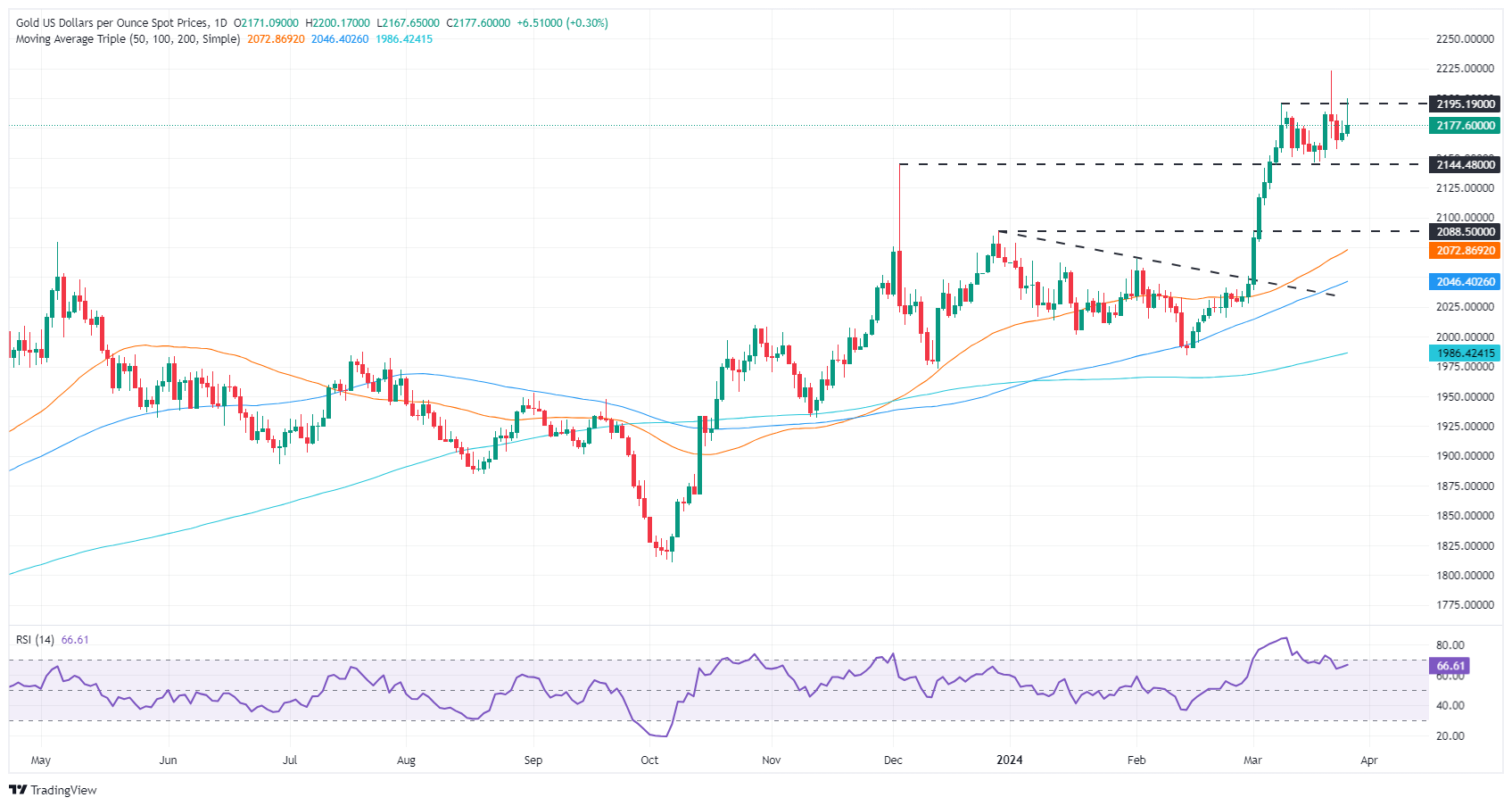- Gold rises amid US Dollar fluctuations and lower US Treasury yields.
- DXY’s slight increase contests Gold’s ascent, but bond rates boost it.
- Mixed US data: High Durable Goods Orders, lower Consumer Confidence sway sentiment.
Gold price trades in the green but is off the day’s highs of $2,200 reached during the overnight session for North American traders amid a weaker US Dollar. At the opening of Wall Street, the Greenback extended its recovery while a fall in US Treasury yields maintained the yellow metal in the green. At the time of writing, XAU/USD trades at $2,177, up 0.31%.
The US Dollar Index (DXY), which measures the Greenback’s performance against the other six currencies, trades flat at 104.30, a headwind for the non-yielding metal. Nevertheless, the US 10-year benchmark note rate edged down one basis point to 4.243%, boosting the precious metal.
The US economic docket showed that Durable Goods Orders rose to their highest level since 2022. In the meantime, the Conference Board suggested that Consumer Confidence declined further in March, reaching its lowest level in four months.
Daily digest market movers: Gold advances amidst strong Durable Goods Orders
- US Durable Goods Orders for February rose by 1.4% MoM, exceeding estimates of 1.1% and January’s -0.9% plunge. The core Durable Goods Orders stood at 0.4% MoM, up from -0.3% and above the consensus of 0.4%.
- The Conference Board (CB) revealed Americans’ confidence was steady in March, yet it ticked down to 104.7 from 104.8, a downward revision from the previous month. This was blamed on higher prices and soaring borrowing costs.
- Federal Reserve officials remain set to cut rates, but there’s division among the Federal Open Market Committee (FOMC) board. Atlanta Fed President Raphael Bostic noted that he expects one rate cut instead of two in 2024. Meanwhile, Fed Governor Lisa Cook echoed Bostic’s comments and added that easing policy too soon increases the risk of inflation becoming entrenched.
- Chicago Fed President Austan Goolsbee remains dovish, expecting three cuts, though he said he needs more evidence of inflation “coming down.”
- Money market traders predict a 70% chance that the Federal Reserve would slash rates by a quarter of a percentage point, setting the federal funds rate (FFR) at 5.00% – 5.25%.
- Gold traders are awaiting the release of the Federal Reserve’s preferred gauge for inflation, the Core Personal Consumption Expenditure (PCE) Price Index. The index is estimated to grow 2.8% YoY in February, with monthly figures expected to slow from 0.4% to 0.3% MoM.
Technical analysis: Gold price stays above $2,170 amid strong US Dollar
Gold price dips toward $2,167, spurring a leg up toward the $2,170 area at around the same time the Relative Strength Index (RSI) made a U-turn and aimed upwards. Nevertheless, buyers must reclaim the $2,200 figure to keep the uptrend unchanged. That will pave the way for re-testing the all-time high of $2,223.
On the flip side, if sellers push prices below the December 4 high, which turned support at $2,146, that could exacerbate a sell-off and send XAU/USD prices diving toward $2,100. The next support would be the December 28 high, which is $2,088.
Fed FAQs
Monetary policy in the US is shaped by the Federal Reserve (Fed). The Fed has two mandates: to achieve price stability and foster full employment. Its primary tool to achieve these goals is by adjusting interest rates. When prices are rising too quickly and inflation is above the Fed’s 2% target, it raises interest rates, increasing borrowing costs throughout the economy. This results in a stronger US Dollar (USD) as it makes the US a more attractive place for international investors to park their money. When inflation falls below 2% or the Unemployment Rate is too high, the Fed may lower interest rates to encourage borrowing, which weighs on the Greenback.
The Federal Reserve (Fed) holds eight policy meetings a year, where the Federal Open Market Committee (FOMC) assesses economic conditions and makes monetary policy decisions. The FOMC is attended by twelve Fed officials – the seven members of the Board of Governors, the president of the Federal Reserve Bank of New York, and four of the remaining eleven regional Reserve Bank presidents, who serve one-year terms on a rotating basis.
In extreme situations, the Federal Reserve may resort to a policy named Quantitative Easing (QE). QE is the process by which the Fed substantially increases the flow of credit in a stuck financial system. It is a non-standard policy measure used during crises or when inflation is extremely low. It was the Fed’s weapon of choice during the Great Financial Crisis in 2008. It involves the Fed printing more Dollars and using them to buy high grade bonds from financial institutions. QE usually weakens the US Dollar.
Quantitative tightening (QT) is the reverse process of QE, whereby the Federal Reserve stops buying bonds from financial institutions and does not reinvest the principal from the bonds it holds maturing, to purchase new bonds. It is usually positive for the value of the US Dollar.
منبع: https://www.fxstreet.com/news/gold-prices-shine-amid-a-strong-us-dollar-despite-pullback-from-daily-highs-202403261902
